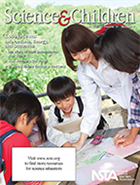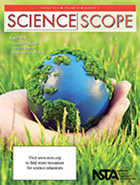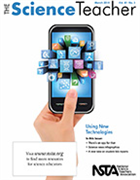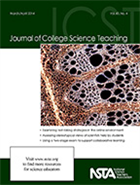NSTA’s K-College Science Education Journals: March 2014 Issues Online
By Lauren Jonas, NSTA Assistant Executive Director
Posted on 2014-03-06
Interactions are our focus this month—in ecosystems and classrooms, among science teachers teaching a variety of disciplines, and using the latest technology. This month’s K-College journals from the National Science Teachers Association have a wealth of articles on how to make the most of the great ideas and possibilities that bubble up via smart collaboration.
 Science and Children
Science and Children
This issue of Science and Children offers engaging ideas, strategies, and resources for helping your students understand how the parts of an ecosystem interact.
Featured articles (please note, only those marked “free” are available to nonmembers with out a fee):
- Free – Editor’s Note: Support for Implementation of NGSS
- Exploring Nature Through a New Lens
- Growing Gardens, Growing Minds
- How Healthy Is Our Pond?
- Free – Our World Without Decomposers: How Scary!
- Outstanding Science Trade Books for Students K–12
- The Amazing Ecology of Terrestrial Isopods
- Full Table of Contents
 Science Scope
Science Scope
Celebrate Earth Day on Tuesday, April 22, 2014, with one or more of the activities found in this issue of Science Scope. We’re sure you’ll find something in this collection that will help focus students’ attention on the world around them and the planet they live on.
Featured articles (please note, only those marked “free” are available to nonmembers without a fee):
- Free – Editor’s Roundtable: Walking a Thin Line
- Get Your Students Outside With Technology
- Greenhouse Design: An Engineering Unit
- Free – How Low Can You Go?: Interdisciplinary Student-Impact Investigations for Environmental Awareness and Sustainability
- Invading the Curriculum: Incorporating Service Learning in the Local Community to Enhance Student Engagement
- Outstanding Science Trade Books for Students K–12
- The Value of a Tree: Comparing Carbon Sequestration to Forest Products
- Full Table of Contents
 The Science Teacher
The Science Teacher
Technology has changed our world. Our classrooms? Not so much. Students spend most of their daily lives interacting with 21st-century technology, but too many classrooms seem stuck in the 19th century, as smartphone and tablet use is often restricted and technology applications are limited. While there are good reasons for schools to be conservative—we don’t want to latch onto the latest gadget of instructional fad—modern technology has the potential to transform education. This edition highlights various ways that teachers are integrating technology into classroom activities, such as designing smartphone apps and colorful infographics, populating Google Earth with data sets, and using screencasts as lab reports. It may well be that we are moving toward a time when tech challenges will not be limited by dollars but only by imagination.
- A New Take on Student Lab Reports
- Free – Editor’s Corner: New Tools—New Possibilities
- Free – Outstanding Science Trade Books for Students K–12
- Pinpointing Watershed Pollution on a Virtual Globe
- Free – Science News Infographics
- There’s An App for That
- Using Infographics in the Science Classroom
- Full Table of Contents
 Journal of College Science Teaching
Journal of College Science Teaching
Read about a new program designed to meet the challenges of educating interdisciplinary scientists by combining mathematics, physics, chemistry, and quantitative thinking with biological applications. The Two-Year Community column describes an initiative in which community college faculty and students partnered with 4-year college colleagues on summer research to cultivate a STEM transfer pathway and expand research capacity at the community college. And in the Research and Teaching section see the article about an unusual method to promote student-centered learning that involved clickers as a mechanism for students to complete in-class quizzes.
Featured articles (please note, only those marked “free” are available to nonmembers without a fee):
- Free – Assessment in Online Learning—It’s a Matter of Time
- Free – Editorial: Good Things
- Examinations That Support Collaborative Learning: The Students’ Perspective
- Explorations in Integrated Science
- Metacognition: An Effective Tool to Promote Success in College Science Learning
- Raising the Bar in Freshman Science Education: Student Lectures, Scientific Papers, and Independent Experiments
- Research and Teaching: Project-Based Instruction With Future STEM Educators: An Interdisciplinary Approach
- Research and Teaching: Student Success Indicators Associated With Clicker-Administered Quizzes in an Honors Introductory Biology Course
- Using the Draw-a-Scientist Test for Inquiry and Evaluation
- Full Table of Contents
Disclaimer: The views expressed in this blog post are those of the author(s) and do not necessarily reflect the official position of the National Science Teaching Association (NSTA).


